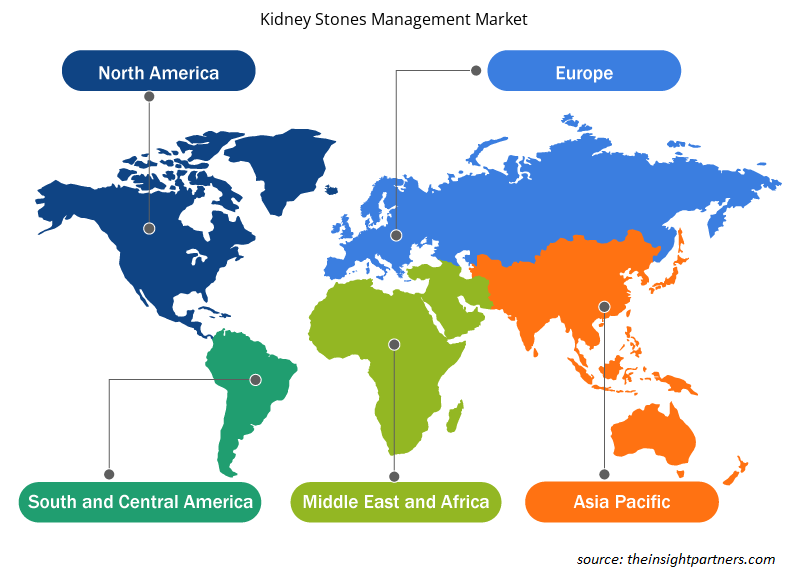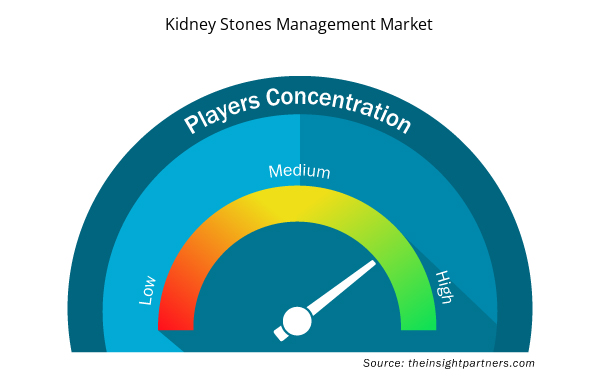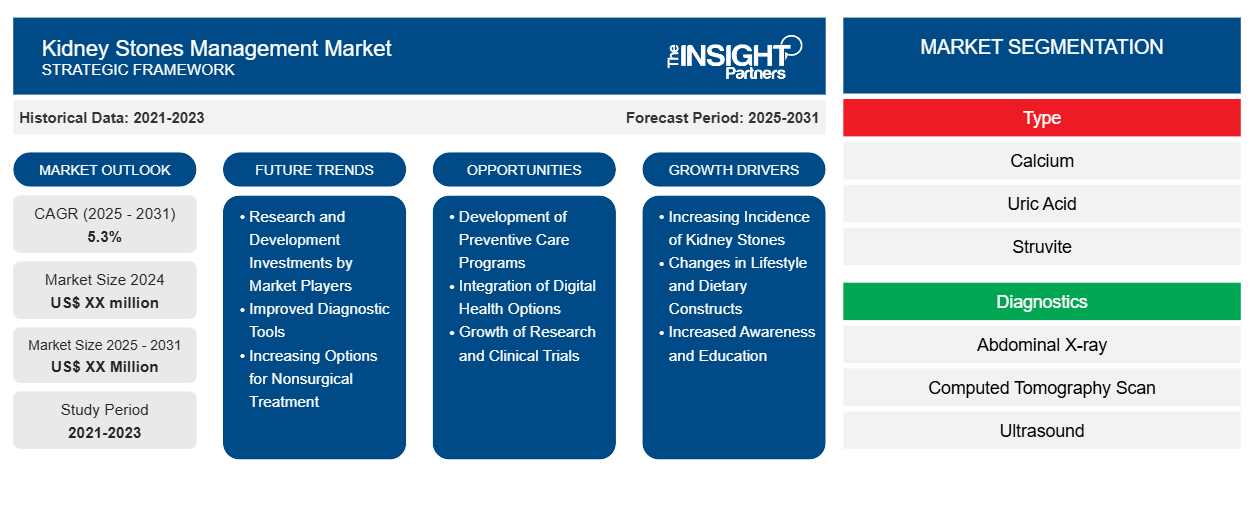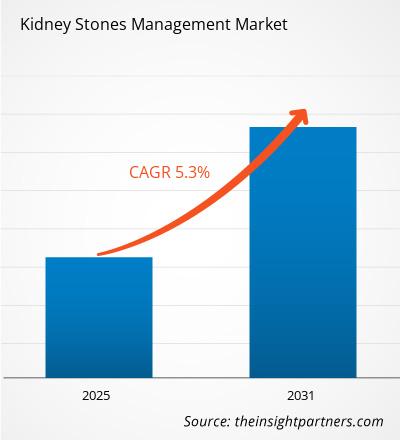Si prevede che il mercato della gestione dei calcoli renali registrerà un CAGR del 5,3% dal 2023 al 2031, con una dimensione di mercato in espansione da XX milioni di dollari nel 2023 a XX milioni di dollari entro il 2031.
Il report è segmentato per tipo (calcio, acido urico, struvite e cisteina); diagnostica (radiografia addominale, tomografia computerizzata, ultrasuoni, risonanza magnetica addominale, pielografia endovenosa e altri); trattamento (litotrissia extracorporea a onde d'urto, ureteroscopia, nefrolitotomia percutanea e altri). L'analisi globale è ulteriormente suddivisa a livello regionale e nei principali paesi. Il report offre il valore in USD per l'analisi e i segmenti di cui sopra.
Scopo del rapporto
Il report Kidney Stones Management Market di The Insight Partners mira a descrivere il panorama attuale e la crescita futura, i principali fattori trainanti, le sfide e le opportunità. Ciò fornirà spunti a vari stakeholder aziendali, come:
- Fornitori/produttori di tecnologia: per comprendere le dinamiche di mercato in evoluzione e conoscere le potenziali opportunità di crescita, consentendo loro di prendere decisioni strategiche informate.
- Investitori: condurre un'analisi completa delle tendenze in merito al tasso di crescita del mercato, alle proiezioni finanziarie del mercato e alle opportunità esistenti lungo la catena del valore.
- Enti di regolamentazione: regolamentano le politiche e le attività di controllo sul mercato allo scopo di ridurre al minimo gli abusi, preservare la fiducia degli investitori e sostenere l'integrità e la stabilità del mercato.
Segmentazione del mercato della gestione dei calcoli renali
Tipo
- Calcio
- Acido urico
- Struvite
- Cisteina
Diagnostica
- Radiografia addominale
- Tomografia computerizzata
- Ultrasuoni
- Risonanza magnetica addominale
- Pielografia endovenosa
- Altri
Trattamento
- Litotrissia extracorporea ad onde d'urto
- Ureteroscopia
- Nefrolitotomia percutanea
- Altri
Geografia
- America del Nord
- Europa
- Asia-Pacifico
- America del Sud e Centro
- Medio Oriente e Africa
Geografia
- America del Nord
- Europa
- Asia-Pacifico
- America del Sud e Centro
- Medio Oriente e Africa
Personalizza questo report in base alle tue esigenze
Riceverai la personalizzazione gratuita di qualsiasi report, comprese parti di questo report, o analisi a livello nazionale, pacchetto dati Excel, oltre a usufruire di grandi offerte e sconti per start-up e università
- Scopri le principali tendenze di mercato in questo rapporto.Questo campione GRATUITO includerà analisi di dati che spaziano dalle tendenze di mercato alle stime e alle previsioni.
Fattori di crescita del mercato della gestione dei calcoli renali
- Aumento dell'incidenza dei calcoli renali: gli studi indicano che nel 2023 l'incidenza dei calcoli renali tra i giovani e i bambini è aumentata del 52% rispetto agli anni precedenti. Questa tendenza allarmante suggerisce che la domanda di trattamenti e interventi diagnostici per la gestione dei calcoli renali è in aumento. Inoltre, i fattori di rischio associati, come le condizioni urologiche che colpiscono la popolazione, stanno generando la necessità di creare consapevolezza riguardo alla salute renale e di screening e diagnosi tempestivi della malattia per ricevere il trattamento.
- Cambiamenti nello stile di vita e nelle strutture dietetiche: i cambiamenti crescenti nello stile di vita e nelle modifiche dietetiche hanno contribuito all'aumento della prevalenza dell'incidenza dei calcoli renali. Il consumo di cibi ricchi di sodio e ossalati senza un'adeguata idratazione sono fattori importanti. Con il crescente numero di persone che soffrono di calcoli renali associati a cambiamenti dietetici, è cresciuta la necessità di gestione. Anche le iniziative di sanità pubblica incentrate sui cambiamenti dietetici contribuiscono ad aumentare grazie alla prevenzione.
- Maggiore consapevolezza e istruzione: con l'aumento della consapevolezza dei calcoli renali e della loro gestione, soprattutto tra il pubblico e gli operatori sanitari, il mercato continuerà a crescere. Campagne e strumenti educativi stanno aiutando le persone consapevoli dei fattori di rischio, dei segni e dei sintomi. Ciò aumenterà la domanda di trattamento dei calcoli renali. Inoltre, si prevede che i fornitori aumenteranno lo screening per i calcoli renali, in particolare quando è ovvio attraverso modelli tra popolazioni ad alto rischio.
Tendenze future del mercato della gestione dei calcoli renali
- Investimenti in ricerca e sviluppo da parte degli operatori di mercato: gli operatori di mercato come Cook Medical e Boston Scientific Corporation sono impegnati nella ricerca e nello sviluppo di tecnologie avanzate per la gestione dei calcoli renali e stanno introducendo innovazioni per fornire opzioni più efficaci per il trattamento. Questa competizione e innovazione portano a miglioramenti nella gestione sia chirurgica che non chirurgica, il che è importante a causa della popolazione eterogenea di pazienti con esigenze di gestione dei calcoli renali. Ad esempio, i nuovi dispositivi di litotripsia sono ora allineati per produrre una migliore precisione ed efficacia nel trattamento dei calcoli renali. Si prevede che gli investimenti per sviluppare e lanciare tali innovazioni stimoleranno la crescita del mercato.
- Strumenti diagnostici migliorati: la tecnologia di imaging come gli ultrasuoni ad alta risoluzione e le scansioni TC ha migliorato la risoluzione del rilevamento dei calcoli renali e può identificare i calcoli nelle fasi iniziali, consentendo piani di trattamento personalizzati ed efficaci. Questi progressi nell'assistenza alimenteranno la domanda di soluzioni nella gestione.
- Aumento delle opzioni per il trattamento non chirurgico: l'adozione di opzioni di trattamento non invasive è in aumento. La litotrissia extracorporea a onde d'urto (ESWL) è solo uno dei diversi metodi non invasivi per il trattamento dei calcoli. Queste opzioni richiedono tempi di inattività inferiori per il paziente rispetto alla chirurgia tradizionale e sono anche meno rischiose per il paziente e il suo team sanitario.
Opportunità di mercato per la gestione dei calcoli renali
- Sviluppo di programmi di assistenza preventiva: con l'aumento delle conoscenze sulla prevenzione dei calcoli renali, si apre la possibilità di un modello di assistenza preventiva più solido, correlato a cambiamenti dietetici e approcci di idratazione basati su fattori di rischio individuali per promuovere la prevenzione. Concentrandoci sulla prevenzione, ridurremo il numero di calcoli renali formati e quindi sorgerà una maggiore domanda di prevenzione dei calcoli renali.
- Integrazione delle opzioni di salute digitale: l'avvento di nuove tecnologie di salute digitale, come applicazioni di monitoraggio remoto e tecnologia indossabile, offre l'opportunità di aumentare l'automedicazione e il monitoraggio dei pazienti. Queste tecnologie aiutano i pazienti a monitorare i loro livelli di idratazione, le abitudini alimentari e l'aderenza ai farmaci, portando a una migliore gestione dei fattori di rischio dei calcoli renali e a risultati migliori.
- Crescita della ricerca e delle sperimentazioni cliniche: c'è un interesse generale crescente nella ricerca relativa alle cause sottostanti la calcolosi renale e ai trattamenti per i calcoli renali. Maggiori finanziamenti per le sperimentazioni cliniche faciliteranno la scoperta di nuove terapie e misure preventive per i calcoli renali, portando a una gamma più ampia di approcci di gestione e anche alla crescita del mercato.
Approfondimenti regionali sul mercato della gestione dei calcoli renali
Le tendenze regionali e i fattori che influenzano il mercato della gestione dei calcoli renali durante il periodo di previsione sono stati ampiamente spiegati dagli analisti di Insight Partners. Questa sezione discute anche i segmenti e la geografia del mercato della gestione dei calcoli renali in Nord America, Europa, Asia Pacifico, Medio Oriente e Africa e America meridionale e centrale.

- Ottieni i dati specifici regionali per il mercato della gestione dei calcoli renali
Ambito del rapporto di mercato sulla gestione dei calcoli renali
| Attributo del report | Dettagli |
|---|---|
| Dimensioni del mercato nel 2023 | XX milioni di dollari USA |
| Dimensioni del mercato entro il 2031 | XX milioni di dollari USA |
| CAGR globale (2023-2031) | 5,3% |
| Dati storici | 2021-2022 |
| Periodo di previsione | 2024-2031 |
| Segmenti coperti | Per tipo
|
| Regioni e Paesi coperti | America del Nord
|
| Leader di mercato e profili aziendali chiave |
|
Densità degli attori del mercato della gestione dei calcoli renali: comprendere il suo impatto sulle dinamiche aziendali
Il mercato della gestione dei calcoli renali sta crescendo rapidamente, spinto dalla crescente domanda degli utenti finali dovuta a fattori quali l'evoluzione delle preferenze dei consumatori, i progressi tecnologici e una maggiore consapevolezza dei benefici del prodotto. Con l'aumento della domanda, le aziende stanno ampliando le loro offerte, innovando per soddisfare le esigenze dei consumatori e capitalizzando sulle tendenze emergenti, il che alimenta ulteriormente la crescita del mercato.
La densità degli operatori di mercato si riferisce alla distribuzione di aziende o società che operano in un particolare mercato o settore. Indica quanti concorrenti (operatori di mercato) sono presenti in un dato spazio di mercato in relazione alle sue dimensioni o al valore di mercato totale.
Le principali aziende che operano nel mercato della gestione dei calcoli renali sono:
- Gruppo Direx,
- Medispec Ltd.,
- Società Stryker,
- Tecnologia medica Dornier,
- Tecnologie laser convergenti,
Disclaimer : le aziende elencate sopra non sono classificate secondo un ordine particolare.

- Ottieni una panoramica dei principali attori del mercato della gestione dei calcoli renali
Punti di forza chiave
- Copertura completa: il rapporto copre in modo completo l'analisi di prodotti, servizi, tipologie e utenti finali del mercato della gestione dei calcoli renali, fornendo una panoramica olistica.
- Analisi degli esperti: il rapporto è compilato sulla base della conoscenza approfondita di esperti e analisti del settore.
- Informazioni aggiornate: il rapporto garantisce la pertinenza aziendale grazie alla copertura di informazioni recenti e tendenze nei dati.
- Opzioni di personalizzazione: questo report può essere personalizzato per soddisfare le esigenze specifiche del cliente e adattarsi in modo appropriato alle strategie aziendali.
Il rapporto di ricerca sul mercato della gestione dei calcoli renali può, quindi, aiutare a guidare il percorso di decodificazione e comprensione dello scenario del settore e delle prospettive di crescita. Sebbene possano esserci alcune preoccupazioni valide, i vantaggi complessivi di questo rapporto tendono a superare gli svantaggi.
- Analisi storica (2 anni), anno base, previsione (7 anni) con CAGR
- Analisi PEST e SWOT
- Valore/volume delle dimensioni del mercato - Globale, regionale, nazionale
- Industria e panorama competitivo
- Set di dati Excel



Report Coverage
Revenue forecast, Company Analysis, Industry landscape, Growth factors, and Trends

Segment Covered
This text is related
to segments covered.

Regional Scope
North America, Europe, Asia Pacific, Middle East & Africa, South & Central America

Country Scope
This text is related
to country scope.
Domande frequenti
Based on type, the market is segmented into abdominal X-ray, computed comography scan, ultrasound, abdominal MRI, intravenous pyelography, and others. The abdominal X-ray segment is expected to hold the largest kidney stones management market share in 2023.
On the basis of end-user market is further broken down into extracorporeal shock wave lithotripsy, ureteroscopy, percutaneous nephrolithotomy, and others. The ureteroscopy segment is expected to hold the largest kidney stones management market share in 2023.
DirexGroup,
Medispec Ltd.,
Stryker Corp,
Dornier Medtech,
Convergent Laser Technologies,
C. R. Bard, Inc.,
Boston Scientific Corporation,
Olympus Corporation,
Storz Medical AG
North America is expected to hold the largest share in the global kidney stones management market.
The major factors driving the kidney stones management market are:
1. Rising Knee Distortion in the Elderly Population.
2. Rising Number of Knee Repair Procedures
The Kidney Stones Management Market is estimated to witness a CAGR of 5.3% from 2023 to 2031
Trends and growth analysis reports related to Life Sciences : READ MORE..
1. DirexGroup,
2. Medispec Ltd.,
3. Stryker Corp,
4. Dornier Medtech,
5. Convergent Laser Technologies,
6. C. R. Bard, Inc.,
7. Boston Scientific Corporation,
8. Olympus Corporation,
9. Storz Medical AG
10. Allengers
11. Cook Medical Inc.
12. Richard Wolf GmbH
13. Lumenis
14. EDAP TMS
The Insight Partners performs research in 4 major stages: Data Collection & Secondary Research, Primary Research, Data Analysis and Data Triangulation & Final Review.
- Data Collection and Secondary Research:
As a market research and consulting firm operating from a decade, we have published and advised several client across the globe. First step for any study will start with an assessment of currently available data and insights from existing reports. Further, historical and current market information is collected from Investor Presentations, Annual Reports, SEC Filings, etc., and other information related to company’s performance and market positioning are gathered from Paid Databases (Factiva, Hoovers, and Reuters) and various other publications available in public domain.
Several associations trade associates, technical forums, institutes, societies and organization are accessed to gain technical as well as market related insights through their publications such as research papers, blogs and press releases related to the studies are referred to get cues about the market. Further, white papers, journals, magazines, and other news articles published in last 3 years are scrutinized and analyzed to understand the current market trends.
- Primary Research:
The primarily interview analysis comprise of data obtained from industry participants interview and answers to survey questions gathered by in-house primary team.
For primary research, interviews are conducted with industry experts/CEOs/Marketing Managers/VPs/Subject Matter Experts from both demand and supply side to get a 360-degree view of the market. The primary team conducts several interviews based on the complexity of the markets to understand the various market trends and dynamics which makes research more credible and precise.
A typical research interview fulfils the following functions:
- Provides first-hand information on the market size, market trends, growth trends, competitive landscape, and outlook
- Validates and strengthens in-house secondary research findings
- Develops the analysis team’s expertise and market understanding
Primary research involves email interactions and telephone interviews for each market, category, segment, and sub-segment across geographies. The participants who typically take part in such a process include, but are not limited to:
- Industry participants: VPs, business development managers, market intelligence managers and national sales managers
- Outside experts: Valuation experts, research analysts and key opinion leaders specializing in the electronics and semiconductor industry.
Below is the breakup of our primary respondents by company, designation, and region:

Once we receive the confirmation from primary research sources or primary respondents, we finalize the base year market estimation and forecast the data as per the macroeconomic and microeconomic factors assessed during data collection.
- Data Analysis:
Once data is validated through both secondary as well as primary respondents, we finalize the market estimations by hypothesis formulation and factor analysis at regional and country level.
- Macro-Economic Factor Analysis:
We analyse macroeconomic indicators such the gross domestic product (GDP), increase in the demand for goods and services across industries, technological advancement, regional economic growth, governmental policies, the influence of COVID-19, PEST analysis, and other aspects. This analysis aids in setting benchmarks for various nations/regions and approximating market splits. Additionally, the general trend of the aforementioned components aid in determining the market's development possibilities.
- Country Level Data:
Various factors that are especially aligned to the country are taken into account to determine the market size for a certain area and country, including the presence of vendors, such as headquarters and offices, the country's GDP, demand patterns, and industry growth. To comprehend the market dynamics for the nation, a number of growth variables, inhibitors, application areas, and current market trends are researched. The aforementioned elements aid in determining the country's overall market's growth potential.
- Company Profile:
The “Table of Contents” is formulated by listing and analyzing more than 25 - 30 companies operating in the market ecosystem across geographies. However, we profile only 10 companies as a standard practice in our syndicate reports. These 10 companies comprise leading, emerging, and regional players. Nonetheless, our analysis is not restricted to the 10 listed companies, we also analyze other companies present in the market to develop a holistic view and understand the prevailing trends. The “Company Profiles” section in the report covers key facts, business description, products & services, financial information, SWOT analysis, and key developments. The financial information presented is extracted from the annual reports and official documents of the publicly listed companies. Upon collecting the information for the sections of respective companies, we verify them via various primary sources and then compile the data in respective company profiles. The company level information helps us in deriving the base number as well as in forecasting the market size.
- Developing Base Number:
Aggregation of sales statistics (2020-2022) and macro-economic factor, and other secondary and primary research insights are utilized to arrive at base number and related market shares for 2022. The data gaps are identified in this step and relevant market data is analyzed, collected from paid primary interviews or databases. On finalizing the base year market size, forecasts are developed on the basis of macro-economic, industry and market growth factors and company level analysis.
- Data Triangulation and Final Review:
The market findings and base year market size calculations are validated from supply as well as demand side. Demand side validations are based on macro-economic factor analysis and benchmarks for respective regions and countries. In case of supply side validations, revenues of major companies are estimated (in case not available) based on industry benchmark, approximate number of employees, product portfolio, and primary interviews revenues are gathered. Further revenue from target product/service segment is assessed to avoid overshooting of market statistics. In case of heavy deviations between supply and demand side values, all thes steps are repeated to achieve synchronization.
We follow an iterative model, wherein we share our research findings with Subject Matter Experts (SME’s) and Key Opinion Leaders (KOLs) until consensus view of the market is not formulated – this model negates any drastic deviation in the opinions of experts. Only validated and universally acceptable research findings are quoted in our reports.
We have important check points that we use to validate our research findings – which we call – data triangulation, where we validate the information, we generate from secondary sources with primary interviews and then we re-validate with our internal data bases and Subject matter experts. This comprehensive model enables us to deliver high quality, reliable data in shortest possible time.


 Ottieni un campione gratuito per questo repot
Ottieni un campione gratuito per questo repot